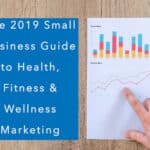When your business goals are ambitious, one of the first hurdles your health club, fitness center or wellness business will face is earmarking a budget for paid digital advertising — most commonly, Google Ads (formerly AdWords), paid Facebook Ads, and paid LinkedIn advertising.
One of the first questions that comes up is: “Do we really have to spend money on pay-per-click advertising? Can’t we just focus on content so people will find us organically?”
The answer is yes. And no.
1. Ranking for your business name
Good news! Even the newest business will usually rank at the top of organic search results for its business name very quickly.
That means that if someone already knows your business name and types it into Google, your business will probably be at the top of the organic, non-paid, search results. That’s good news for current members who want to check your class schedule or gym hours. It’s also good news for past members who want to see what’s changed since they last experienced your club.
Here’s the problem, though:
First, most wellness businesses aren’t household names, or chains, or franchisees. Compare that to, say, Subway. If you’re traveling and hungry and you like deli sandwiches, it’s quite likely that you’ll just search for “subway near me” — and find one, no matter where you are, urban or rural, big or small.
So most potential new members don’t know about your business yet. And if they don’t know your name, so what’s the probability that they’ll search for you by name? That’s right, zero.
Second, organic search results show up after paid ads and after Google Business listings in Google search results. If you rely strictly on organic placement, you’ll virtually never be at the top of the page. That’s bad, because top of page results nearly always get far more clicks than other links farther down the search results page.
Your organic content will be in the third and last group of results, which usually gets the least engagement.
Finally, local competitors may well include your business name as a keyword for one of their Google ads. That ad will appear at or near the top of the search results page. That means that even people searching specifically for your business are likely to see a competitor’s ad higher up on the page than your own content — even though they searched for your business by name.
Bottom-line: while ranking for your own business name is valuable, it often doesn’t significantly benefit new member acquisition. That’s especially true if your local name recognition is low — which it probably is.
2. Ranking for health and fitness content
Too many brick-and-mortar health clubs, fitness businesses and wellness centers have been sold a bill of goods — namely, that generic health and fitness articles like “Five Ways To Mix Up Your Cardio” or “Superfoods: What Are They?” or “Are Your Hamstrings A Problem Waiting To Happen?” are the key to acquiring new customers without having to spend money on pay-per-click or other digital or print advertising.
Studies have shown repeatedly that getting first-page ranking for this kind of content takes approximately forever. And if your business and website are brand-new, you can double that estimate. (Okay, the real number was over a year, even for highly-optimized content.)
You cannot build a business on this kind of content marketing. Yes, we know it’s cheap and you can buy blog posts like this literally by the dozen. If they actually worked, they’d cost considerably more!
That’s because:
- Articles like these already exist all over the web. Your post is simply one more website repeating information that’s already commonly available.
- Articles like these don’t attract prospects. People trying to pick a health club have completely different concerns: “Can I cancel my contract if I lose my job” and “Do you have an indoor pool and childcare?” and “Will I fit in here?”
So the likelihood that someone considering a club membership will find your website through this kind of content is incredibly low.
Plus, even if this kind of content did work:
- You’re late to the party. Google decides which sites to present first within organic results using algorithms that draw on a long list of “ranking signals” including content longevity and relevance (like clicks, visits, time on page, time on site)
Globally-viewed linkbait sites like livestrong.com will always outrank your local content, which is discovered and viewed only by the tiniest of audiences in comparison.
Bottom-line: you’ll be incredibly lucky if your own generic health and fitness content ever makes it to even the second or third page of organic results, much less the first.
3. Ranking for locally-optimized health and fitness content
Localized and highly-relevant organic health and fitness content greatly increases the likelihood that potential clients and customers will find your business. Now, it’s important to understand: this is a “shotgun” approach, not a “rifle.” In other words, it will attract lots of people interested in your areas of expertise — but many of them aren’t looking to buying anything from anyone including your business. However, buried within those folks will be some who are highly likely to become your client or member.
For example, an article on the “Five Best Denver, CO Running Paths for Marathon Training” actually has a decent shot at winning organic traffic — and prospects for your running club’s training programs.
And a blog post like “Try The Dallas, TX Farmers Market for Locally-Grown Superfoods” will almost certainly attract folks interested in health, nutrition and fitness, some of whom will probably be quite interested in your wellness center’s nutrition coaching and healthy lifestyle programs.
Bottom-line: general-interest health content will rank more quickly the more you localize it.
4. Ranking for locally-optimized sales acceleration content
The most effective organic content is locally-optimized and focused on the concerns of people seriously considering a purchase. In contrast to #3 above, this is a “rifle” approach that zeroes in on people with a demonstrated interest in both your subject matter expertise and actually buying it from you in the form of a program, service or membership.
For example, “Choosing The Right Chicago Sports Conditioning Center For Club & Elite Soccer” with plenty of references to your home market of Chicago will probably rank pretty quickly in search results for Chicago parents who want to upgrade their child’s soccer coaching.
And a post like “San Jose Fitness Buyer’s Guide: Health Clubs vs Gyms vs Fitness Studios” is highly likely to rank well in your local market for people considering a variety of fitness-related purchases.
Bottom-line: if your priority is sales, invest in content that is both locally-optimized and tailored to the specific concerns and interests of people considering a purchase.
Now, let’s revisit the original question
Can you successfully substitute organic content ranking for pay-per-click advertising?
Yes, when you invest in locally-optimized content tailored to your prospects’ decisionmaking process — the “rifle” approach.
Maybe, if you pursue a “shotgun” strategy using localized health and fitness content and can tolerate slow, incremental, reactive customer growth.
No, if you pursue a “rifle” strategy built on generic health and fitness content, or your investors expect rapid customer and revenue growth.




